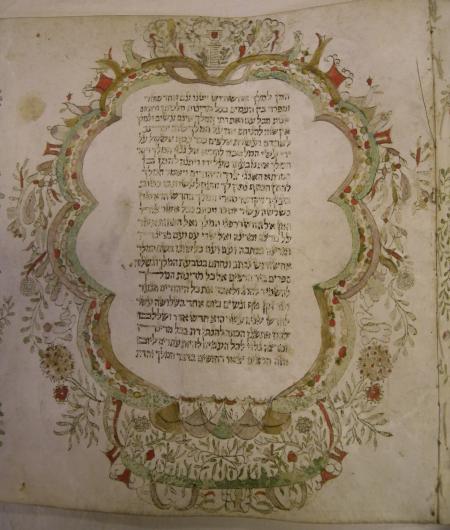Obj. ID: 38123
Hebrew Illuminated Manuscripts JMNY Esther Scroll with Polylobed Text Panels and Floral Decoration, Italy, 18th century

The opening section of the scroll is blank and trimmed into a cone shape. The Hebrew text of the Book of Esther is written in rectangular columns placed within polylobed text panels formed of nine semicircles each; such irregular text panels can be rarely found in decorated megillot Esther. In every second panel, the semicircles are doubled, and then in the upper part, there is a half-column (or high pedestal) and a vase with plants placed atop it. These panels are surrounded by floral motifs together with abstract forms. Whereas at the top of every second panel, there is a vase with long leafy twigs with flowers (?) falling on either side and surrounding the panel. There are only two narrative scenes from the Book of Esther - the hanging of Haman (Es. 7:10) and the hanging of his sons (Es. 9:14) - that are depicted below the panels.
The scroll is mounted on a wooden roller.
Small nails were used to join the scroll to a roller.
Light green pigment in the scrolls' decorations could be the remnant of gold paint that has flaked off.
sub-set tree:
The length of the sheets in the scroll: 1) ca. 700 mm, 2) 540 mm, 3) 570 mm, 4) 550 mm, 5) 570 mm, 6) 535 mm, 7) ca. 420 mm.
Dimensions of the selected details in the scroll:
- text column: 130x75 mm;
- an average letter: 3 mm;
- letters in col. 17: 6 mm;
- spaces between the lines of the text: 3 mm.
The roller: ca. 400 mm (hight).
The text in the scroll is preserved in poor condition; the ink is faded, in others has flaked off, therefore, in some places, the text is barely visible.
The decorations are in better condition but some damage can be noticed in them. Even in the most damaged sheet, the first, the decoration is preserved, albeit with faded paints.
The last membrane is torn.
The Book of Esther in Hebrew
The scroll is formed of 7 sheets containing 20 columns of the text with 21-23 lines each, except for col. 17 with has 11 lines divided into two half-columns.
The first six sheets contain 3 text columns and the last sheet contains two columns.
The text is inscribed in Hebrew Italian square script with tagin, in black ink on the parchment membranes, which are rather thin and stiff.
The letter ח (Es. 1:6) is highlighted by its form - it is formed of two elements joined with a roof, it is enlarged and decorated with two tagin. The letter ת (Es. 9:29) is enlarged and bolded. Other enlarged and diminished letters are included in col. 17.
Numerous letters in col. 16 are elongated.
The ruling and pricking are invisible.
The membranes in the scroll are stitched together.
None
No bibliography on the scroll is available.





















